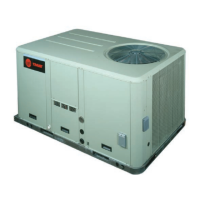Pre-Start
RT-SVX21AC-EN 51
Test Modes
There are three methods in which the “Test” mode can be
cycled at LTB-Test 1 and LTB-Test 2.
1. Step Test Mode - This method initiates the different
componen
ts of the unit, one at a time, by temporarily
shorting across the two test terminals for two to three
seconds. For the initial start-up of the unit, this method
allows the technician to cycle a component “On” and
have up to one hour to complete the check.
2. Resistance Test Mode - This method can be used for
start-up
providing a decade box for variable resistance
outputs is available. This method initiates the different
components of the unit, one at a time, when a specific
resistance value is placed across the two test
terminals. The unit will remain in the specific test mode
for approximately one hour even though the
resistance is left on the test terminals.
3. Auto Test Mode - This method is not recommended
for
start-up due to the short timing between individual
component steps. This method initiates the different
components of the unit, one at a time, when a jumper
is installed across the test terminals. The unit will start
the first test step and change to the next step every 30
seconds.
At the end of the test mode,
control of th
e unit will
automatically revert to the applied “System” control
method.
For unit test steps, test modes, and step resistance values
to cycle the various components, refer to Table 16, p. 51.
ReliaTel™ Controls
Upon power initialization, the Gas Ignition Module (IGN)
performs self-diagnostic checks to insure that all internal
controls are functional. It also checks the configuration
parameters against the components connected to the
system. The System LED located on the IGN module is
turned “On” within one second of power-up if internal
operation is okay.
Electromechanical Controls Test
Procedure
See unit schematic for correct wire numbers.
Fan Test and Minimum Ventilation
Connect red thermostat wire (R) to black thermostat wire
(G).
Economizer Cooling
Connect a jumper wire across OTS on Economizer Control
(ECA).
Connect red thermostat (R) wire to yellow thermostat
wire
(Y1).
Cool 1
Connect red thermostat wire (R) to yellow thermostat wire
(Y1).
Table 16. Service test guide for component operation
Test Step Mode Fan Econ
(a)
Comp 1 Comp 2 Heat 1 Heat 2 Resistance
PWM
Output
(b)
Multi-Speed Fan
Output
1
Fan On
Minimum
Positio
n
Setpoint 0%
Off Off Off Off
2.2K
Ω 50% low
Minimum
Ventilation
On Selectable Off Off Off Off
2
Economizer
Test Open
On Open Off Off Off Off 3.3K
Ω 50%
(c)
low
3
Cool
Stage 1
On
Minimum
Position
On
(d)
Off Off Off 4.7KΩ 82% low
4
(e)
Cool
Stage 2
On
Minimum
Position
On (d) On (d) Off Off 6.8K
Ω 100%
High (2-step cooling)
Low (3-step cooling)
5 (e)
Cool
Stage 3
On
Minimum
Position
On (d) On (d) Off Off 8.2K
Ω 100% High
6 (e) Reheat On Minimum On On Off Off 33K
Ω 100%
(f)
High
7 (e)
Heat
Stage 1
On Minimum Off Off On Off 10K
Ω 100% High
8 (e)
Heat
Stage 2
On Minimum Off Off On On 15K
Ω 100% High
(a) The exhaust fan will turn on anytime the economizer damper position is equal to or greater than the exhaust fan setpoint.
(b) The PWM Output is in reference to the user selected maximum unit fan speed.
(c) Regardless of the Economizer Mode configuration, the unit will run the Supply Fan at the minimum speed during the Economizer step of the Service Test.
(d) The condenser fans will operate any time a compressor is ‘On’ providin
g the outdoor air temperatures are within the operating values.
(e) Steps for optional accessories and non-applica
ble modes in unit will be skipped.
(f) Units with Enhanced Dehumidification only will no
t perform this step during Service Test.

